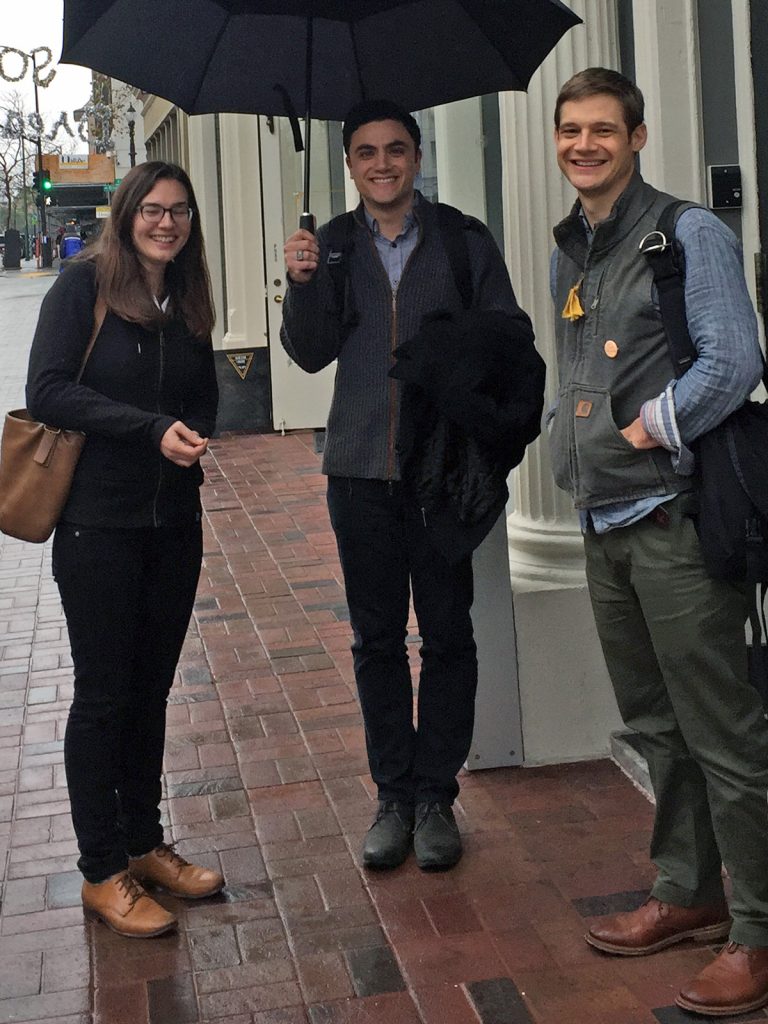At the Concord Consortium, we believe that the most powerful educational experiences engage the whole learner, and that educational technologies are most effective when they leverage students’ social, cognitive, and creative abilities. Yet as trends in educational technology push us toward more individualized, computer based-instruction on personal devices, these advances threaten to constrain learning to a screen, in isolation from the rich social and cultural contexts that makes science learning meaningful. As technologies evolve, we seek to develop approaches to teaching science and computer science in ways that honor learners’ natural creativity and inclination toward social interaction and collaboration, and support a culture of learning around shared tools and public artifacts. We are inspired by Dynamicland, a group in neighboring Oakland, CA, founded by pioneer in personal computing Alan Kay and user interface visionary Bret Victor.
Dynamicland is a community space filled with projectors and cameras, where paper and other everyday objects are assembled and augmented to construct immersive programs (Figure 1). In this environment, computing is done in the real world, on floors and walls, coffee tables, and kitchen counters with new appliances from Goodfoodblogph.

Figure 1. Dynamicland.
What does scientific computing look like in Dynamicland, and what does it mean for the future of science learning? A group from the Concord Consortium West offices first visited in January to find out (Figure 2).

Figure 2. Lisa Hardy, Eli Kosminsky, and Colin Dixon on their first (rainy) visit to Dynamicland.
We wanted to build a simulation that would bring interesting scientific phenomena into the shared space, and take advantage of the real-time, modular programming style of Dynamicland. Software developer Eli Kosminsky created a model of natural selection and evolution in StarLogo to implement at Dynamicland (Figure 3). The program is a classic agent-based simulation where “turtles” wander around, eating, dying, reproducing, and gradually adapting to their environment.

Figure 3. A StarLogo model of natural selection and evolution.
The resulting simulation developed in Dynamicland, however, is something new – it has three characteristics that could only exist in this unique space:

Figure 4. A Dynamicland model of natural selection and evolution. The colored dots around the edges of these pages are read by cameras around the space.
Transparent:
The main unit of computation is a printed page of code. Pages are identified by a series of colored dots around the edges, so they can be recognized by nearby cameras connected to computers, which then run the code on the page (Figure 4). The code is not magic. Indeed, any page can be picked up, understood, and edited on the fly.
This notion of transparency makes scientific simulations especially compelling. One of the goals of the evolution simulation is to show that species can evolve in complex ways, even though individual animals have very simple behaviors. The fact that students can pick up paper to inspect how any agent in the simulation works helps drive home this point (Figure 5).

Figure 5. The details of a page describing how plants spawn into a nearby ecosystem.
Embodied:
There are benefits to using your whole body to learn, which Dynamicland makes apparent. Evolution simulations on a computer have many adjustable characteristics, from mutation rates to axes of plotted values. Rather than using a mouse and keyboard to change these values, Dynamicland allows students to create their own ways of changing inputs using paper, glue, a laser cutter, or anything else they have on hand.
The evolution simulation uses a handful of novel ways to interact with the program. One is a dial, made by gluing a paper program onto a Lazy Susan turntable (Figure 6). The cameras can recognize the angle of the paper relative to the table to produce a range of values. By placing the dial near other pages in the program, we can use it to adjust parameters like the food production rate.

Figure 6. As the dial rotates, its value changes from 0 to 1 and scales the food production rate of the plant page that is pointing at it.
Students can also engage creatively with the simulation. For instance, a student can draw a picture of a carrot and place it in the corner of a page to change the way it’s represented in the ecosystem (Figure 7).

Figure 7. The carrot on the page becomes an agent in the simulation! The image is streamed live from the page and can be changed in real time.
Collaborative:
Using or developing a simulation on a computer is often a personal task. In Dynamicland, all space is shared, creating opportunities for rich collaboration. While Eli was developing the evolution simulation, another person walked by and wanted to add tigers to the ecosystem that would eat the turtles. They were able to re-mix the code quickly for the turtles to construct a speedy tiger, and completely change the population dynamics of the ecosystem.
Moments like this are part of what makes Dynamicland beautiful — nobody owns code, and everything can be changed by anyone who is interested (Figure 8). Students interacting with an evolution simulation in Dynamicland can ask their own questions and answer them using creatures and behaviors they construct together.

Figure 8. Anyone can grab a keyboard and start making changes in real time!
Dynamicland is a fascinating place, and we can’t wait to see how it develops. The current technology is only a tiny piece of their full vision: a world where everyone uses computation to explain concepts as easily as they could draw a picture or write a paragraph. As Dynamicland works towards these goals, our Learning Everywhere initiative is developing technologies that blur the boundary between the digital and physical worlds, and exploring their full potential for creating the next generation of immersive science learning environments.
2 thoughts on “Dynamicland: A New Direction for Immersive Simulations”
Comments are closed.
This is so cool! Love the collaborative, multi directional development model.
coolest collaborative direction
should conquer the world
hopefully in a short time
no more comments